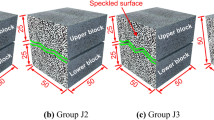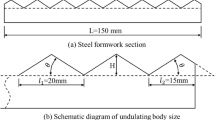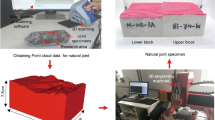Abstract
Experimental measurements to characterize the shear behavior of jointed rocks are essential for any analysis of slopes, underground structures, and foundations, especially in earthquake-prone regions. The main objective of this investigation is to conduct a rational analysis of dynamic shear experiments to make inferences in what extent the engineering parameters may be modified during any earthquake loading. The observed trends in total friction angle (ϕb + i) and basic friction angles (ϕb) under static and dynamic loadings of rock joints were investigated in this study. To determine the (ϕb + i) and (ϕb) of rock joints, the peak shear stress values versus normal stresses were experimentally assessed by using Patton’s bi-linear failure criterion. The measured (ϕb + i) during the dynamic direct shear tests were compared with those measured from the static shear tests. It was found that the (ϕb + i) for both loading conditions did not change significantly. However, (ϕb) obtained from dynamic loading mostly reduced as much as 50%, when compared with those of the static conditions. Direct shear test results also indicated that the most of irregularities sheared off after normal stresses of 2.0 MPa. Thus, at the surface or near-surface designs up to 100 m depth, the (ϕb + i) obtained from the static direct shear tests can be used for dynamic loading conditions safely. For underground designs deeper than 100 m, the (ϕb) should be considered and be reduced at least 50% to simulate dynamic loading conditions.








Similar content being viewed by others
References
Alejano LR, Gonzalez J, Muralha J (2012) Comparison of different techniques of tilt testing and basic friction angle variability assessment. Rock Mech Rock Eng 45:1023–1035
Amadei B, Saeb S (1990) Constitutive models of rock joints. 4-6 June 1990 International Symposium on Rock Joints (Leon, Norway), conferance paper, pp 581–594, A.A. Balkema, Rotterdam/ Netherlands
Asadollahi P, Tonon F (2010) Constitutive model for rock fractures: revisiting Barton’s empirical model. Eng Geol 113:11–32
Bandis SC, Lumsden AC, Barton N (1981) Experimental studies of scale effects on the shear behaviour of rock joints. International Journal of Rock Mechanics and Mining Sciences & Geomechanics Abstracts 18:1–21
Barbero M, Barla G, Zaninetti A (1996) Dynamic shear strength of rock joints subjected to impulse loading. International Journal of Rock Mechanics and Mining Sciences & Geomechanics Abstracts 33:141–151
Barla G, Barbero M, Scavia C (1990) Direct shear testing of single joints under dynamic loading. Rock joints, Proceedings of International symposium. N. Barton, and Stephansson, O., Eds. Loen, Balkema, Rotterdam, pp. 447–454
Barton N (1973) Review of a new shear strength criterion for rock joints. Eng Geol 7:287–332
Barton N, Choubey V (1977) The shear strength of rock joints in theory and practice. Rock Mech 10:1–54
Crawford AM, Curran JH (1981) The influence of shear velocity on the frictional resistance of rock discontinuities. Inv J Rock Mech Min Sci Geomech Abstr 18:505–515
CESMD (2020) USGS, Center for Engineering Strong Motion Data URL: retrieved August, 2019, from https://www.strongmotioncenter.org/
Dai ML, Li TC (2007) Analysis of dynamic stability safety evaluation for complex rock slopes by strength reduction numerical method. Chin J Rock Mech Eng 26(1):2749–2754
Dang W, Konietzky H, Frühwirt T (2016) Direct shear behavior of a plane joint under dynamic normal load (DNL) conditions. Eng Geol 213:133–141
Eshiet KI, Sheng Y (2015) Inter-relationship between joint dilatancy and frictional resistance: impact on fracture behaviour. In: Proceedings of IOP Conference Series: Earth and Environmental Science. 26(1): 1–18
Fathi A, Moradian Z, Rivard P, Ballivy G (2016) Shear mechanism of rock joints under pre-peak cyclic loading condition. Int J Rock Mech Min Sci 83:197–210
Ferrero AM, Migliazza M, Tebaldi G (2010) Development of a new experimental apparatus for the study of the mechanical behaviour of a rock discontinuity under monotonic and cyclic loads. Rock Mech Rock Eng 43(6):685–695
Fox DJ, Kana DD, Hsiung SM (1998) Influence of interface roughness on dynamic shear behavior in jointed rock. Int J Rock Mech Min Sci 35(7):923–940
Gens A, Carol I, Alonso EE (1990) A constitutive model for rock joints formulation and numerical implementation. Comput Geotech 9:3–20
Gillette DR, Sture S, Ko HY, Gould MC, Scott GA (1983) Dynamic behavior of rock joints. Proceedings of the 24th U.S. Symposium on Rock Mechanics, pp. 163–179
Grasselli G, Egger P (2003) Constitutive law for the shear strength of rock joints based on three-dimensional parameters. Int J Rock Mech Min Sci 40:25–40
Harp EL, Hartzell SH, Jibson RW, Ramirez-Guzman L, Schmitt RG (2014) Relation of landslides triggered by the Kiholo Bay Earthquake to modeled ground motion. Bull Seismol Soc Am 104(5):2529–2540
Hencher SR, Richards LR (1989) Assessing the shear strength of rock discontinuities at laboratory and field scales. Rock Mech Rock Eng 48(3):883–905
Homand–Etienne F, Lefevre F, Belem T, Souley M (1999) Rock joints behavior under cyclic direct shear tests. Proc. 37th U.S. Rock Mechanics Symp. Colorado U.S.A, Balkema, pp. 399–406
Hosseini KA, Pellet F, Jafari MK, Boulon M (2004) Shear strength reduction of rock joints due to cyclic loading. 13th World Conference on Earthquake Engineering, August 1–6, 2004, Paper No. 3070, Vancouver, B.C., Canada
Huang X, Haimson BC, Plesha ME, Qiu X (1993) An investigation of the mechanics of rock joints–part 1. laboratory investagation. International J Rock Mech Mining Sci 30(3): 257–269
Hutson RW, Dowding CH (1990) Joint asperity degradation during cyclic shear. Int J Rock Mech Min Sci Geomech Abstr 27:109–119
Indraratna B, Mirzaghorbanali A, Oliveira D AF, Premadasa W (2012) Shear behaviour of rock joints under cyclic loading. In G. A. Narsilio, A. Arulrajah & J. Kodikara (Eds.), 11th Australia - New Zealand Conference on Geomechanics: Ground Engineering in a Changing World (pp. 1256–1261). Australia: Engineers Australia
Jafari MK, Hosseini KA, Pellet F, Boulon M, Buzzi O (2003) Evaluation of shear strength of rock joints subjected to cyclic loading. Soil Dynamic and Earthquake Engineering 23:619–630
Jang HS, Zhang QZ, Kang SS, Jang BA (2017) Determination of the basic friction angle of rock surfaces by tilt tests. Rock Mech Rock Eng 51:989–1004
Jing L, Stephansson O, Nordlund E (1993) Study of rock joints under cyclic loading conditions. Rock Mech Rock Eng 26(3):215–232
L Jing O Stephansson 2007 Fundamentals of discrete element methods for rock engineering. Developments in geotechnical engineering, 85 Elsevier Ampsterdam, Netherlands 543
Karami A, Stead D (2008) Asperity degradation and damage in the direct shear test: a hybrid FEM = DEM approach. Rock Mech Rock Engng 41(2):229–266
Konietzky H, Frühwirt T, Luge H (2012) A new large dynamic rock mechanical direct shear box device. Rock Mech Rock Eng 45(3):427–432
Ladanyi B, Archambault G (1969) Simulation of shear behavior of a jointed rock mass. 11th US Symposium on Rock Mechanics (USRMS), American Rock Mechanics Association, pp. 105–125
Lee HS, Park YJ, Cho TF, You KH (2001) Influence of asperity degradation on the mechanical behavior of rough rock joints under cyclic shear loading. Int J Rock Mech Min Sci 38:967–980
Li Y, Sun S, Tang C (2019a) Analytical prediction of the shear behaviour of rock joints with quantified waviness and unevenness through wavelet analysis. Rock Mech Rock Eng 1–13
Li Y, Tang C, Li D, Wu C (2019b) A new shear strength criterion of three-dimensional rock joints Rock Mech. Rock. Eng. https://doi.org/10.1007/s00603-019-01976-5
Li B, Ye X, Dou Z, Zhao Z, Li Y, Yang Q (2020) Shear strength of rock fractures under dry, surface wet and saturated conditions Rock Mech Rock Eng 53:2605–2622
Liu XR, Liu YQ, Lu YM, Li XW, Li P (2016) Numerical analysis of evaluation methods and influencing factors for dynamic stability of bedding rock slope. J Vibroeng 19(3):1937–1961
Mirzaghorbanali A, Nemcik J, Aziz N (2014) Effects of shear rate on cyclic loading shear behaviour of rock joints under constant normal stiffness conditions. Rock Mech Rock Eng 47:1931–1938
Nemcik J, Mirzaghorbanali AA, N. (2014) An elasto-plastic constitutive model for rock joints under cyclic loading and constant normal stuffness conditions. Geotech Geol Eng 32:321–335
Niktabar SMM, Seshagiri RK, Shrivastava AK (2017) Effect of rock joint roughness on its cyclic shear behavior. Journal of Rock Mechanics and Geotechnical Engineering 9:1071–1084
Oh J, Cording E, Moon T (2015) A joint shear model incorporating small-scale and large-scale irregularities. Int J Rock Mech Min 76:78–87
Ohnishi Y, Chan T, Jing L (1996) Constitutive models for rock joints. Developments in Geotechnical Engineering. Dev Geotech Eng 79:57–92
Patton FD (1966) Multiple modes of shear failure in rock. The 1st Congress of the International Society of Rock Mechanics, Lisbon, pp. 509–513
Plesha ME (1987) Constitutive models for rock discontinuities with dilatancy and surface degradation. Int J Numer Anal Methods Geomech 11:345–362
Pötsch M, Blümel M, Schieg T, Seywald C (2007) The dilation potential of rough rock joints under CNL and CNS conditions. In: Proceedings of 11th Congress of the International Society for Rock mechanics, Lisbon. Taylor and Francis Group; p. 455–460
Qiu X, Plesha ME, Huang X, Haimson BC (1993) An investigation of the mechanics of rock joints—part II: analytical investigation int. J Rock Mech Min Sci Geomech Abstr 30 (3): 271–287
Ruiz J, Li C (2014) Measurement of the basic friction angle of rock by three different tilt test methods. In Alejano L, Perucho A, Olalla C, Jimenez R (eds) ISRM Regional Symposium, May 2014 - EUROCK 2014, Paper Number: ISRM-EUROCK-2014-039. Vigo, Spain; Balkema, Rotterdam
Shrivastava AK, Rao KS (2013) Shear behaviour of rock joints under CNS boundary conditions, Proceedings of the 18th International Conference on Soil Mechanics and Geotechnical Engineering, Paris 2013, pp: 961–64
Schneider H (1976) The friction and deformation behaviour of rock joints. Rock Mech 8(3):169–184
Thevenet D, Créachcadec R, Sohier L (2013) Experimental analysis of the behavior of adhesively bonded joints under tensile/compression–shear cyclic loadings. Int J Adhes Adhes 44:15–25
Wines DR, Lilly PA (2003) Estimates of rock joint shear strength in part of the Fimiston open pit operation in Western Australia. Int J Rock Mech Min Sci 40:929–937
Wu Y, Liu D, Song Q, Ou Y (2013) Reliability analysis of slope dynamic stability based on strength reduction FEM. Rock and Soil Mechanics 34(7):2084–2090
Yang ZY, Chiang DY (2000) An experimental study on the progressive shear behavior of rock joints with tooth-shaped asperities. Int J Rock Mech Min Sci Geomech Abstr 37:1247–1259
Zhang C, Pekau OA, Jin F, Wang G (1997) Application of distinct element method in dynamic analysis of high rock slopes and blocky structures. Soil Dyn Earthq Eng 16:385–394
Author information
Authors and Affiliations
Corresponding author
Ethics declarations
Conflict of interest
The authors declare that they have no competing interests.
Additional information
Responsible Editor: Zeynal Abiddin Erguler
Rights and permissions
Springer Nature or its licensor holds exclusive rights to this article under a publishing agreement with the author(s) or other rightsholder(s); author self-archiving of the accepted manuscript version of this article is solely governed by the terms of such publishing agreement and applicable law.
About this article
Cite this article
Kayabali, K., Habibzadeh, F. & Selçuk, L. A comparative evaluation of shear behaviour of rock joints under static and dynamic loading. Arab J Geosci 15, 1615 (2022). https://doi.org/10.1007/s12517-022-10912-x
Received:
Accepted:
Published:
DOI: https://doi.org/10.1007/s12517-022-10912-x




